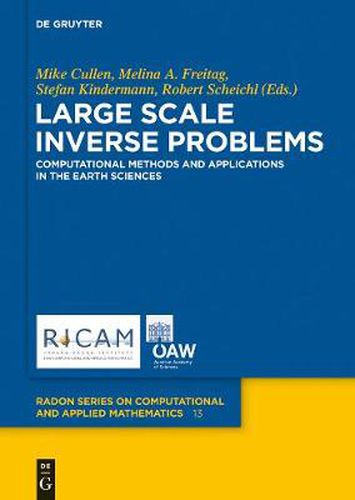Readings Newsletter
Become a Readings Member to make your shopping experience even easier.
Sign in or sign up for free!
You’re not far away from qualifying for FREE standard shipping within Australia
You’ve qualified for FREE standard shipping within Australia
The cart is loading…






This book is thesecond volume of a three volume series recording the Radon Special Semester 2011 on Multiscale Simulation & Analysis in Energy and the Environment that took placein Linz, Austria, October 3-7, 2011. This volume addresses the common ground in the mathematical and computational procedures required for large-scale inverse problems and data assimilation in forefront applications.
The solution of inverse problems is fundamental to a wide variety of applications such as weather forecasting, medical tomography, and oil exploration. Regularisation techniques are needed to ensure solutions of sufficient quality to be useful, and soundly theoretically based. This book addresses the common techniques required for all the applications, and is thus truly interdisciplinary.
Thiscollection of surveyarticlesfocusses onthe large inverse problems commonly arising in simulation and forecasting in the earth sciences. For example, operational weather forecasting models have between 107 and 108 degrees of freedom. Even so, these degrees of freedom represent grossly space-time averaged properties of the atmosphere. Accurate forecasts require accurate initial conditions. With recent developments in satellite data, there are between 106 and 107 observations each day. However, while these also represent space-time averaged properties, the averaging implicit in the measurements is quite different from that used in the models. In atmosphere and ocean applications, there is a physically-based model available which can be used to regularise the problem. We assume that there is a set of observations with known error characteristics available over a period of time. The basic deterministic technique is to fit a model trajectory to the observations over a period of time to within the observation error. Since the model is not perfect the model trajectory has to be corrected, which defines the data assimilation problem. The stochastic view can be expressed by using an ensemble of model trajectories, and calculating corrections to both the mean value and the spread which allow the observations to be fitted by each ensemble member. In other areas of earth science, only the structure of the model formulation itself is known and the aim is to use the past observation history to determine the unknown model parameters.
The book records the achievements of Workshop2 Large-Scale Inverse Problems and Applications in the Earth Sciences . Itinvolves experts in the theory of inverse problems together with experts working on both theoretical and practical aspects of the techniques by which large inverse problems arise in the earth sciences.
$9.00 standard shipping within Australia
FREE standard shipping within Australia for orders over $100.00
Express & International shipping calculated at checkout
This book is thesecond volume of a three volume series recording the Radon Special Semester 2011 on Multiscale Simulation & Analysis in Energy and the Environment that took placein Linz, Austria, October 3-7, 2011. This volume addresses the common ground in the mathematical and computational procedures required for large-scale inverse problems and data assimilation in forefront applications.
The solution of inverse problems is fundamental to a wide variety of applications such as weather forecasting, medical tomography, and oil exploration. Regularisation techniques are needed to ensure solutions of sufficient quality to be useful, and soundly theoretically based. This book addresses the common techniques required for all the applications, and is thus truly interdisciplinary.
Thiscollection of surveyarticlesfocusses onthe large inverse problems commonly arising in simulation and forecasting in the earth sciences. For example, operational weather forecasting models have between 107 and 108 degrees of freedom. Even so, these degrees of freedom represent grossly space-time averaged properties of the atmosphere. Accurate forecasts require accurate initial conditions. With recent developments in satellite data, there are between 106 and 107 observations each day. However, while these also represent space-time averaged properties, the averaging implicit in the measurements is quite different from that used in the models. In atmosphere and ocean applications, there is a physically-based model available which can be used to regularise the problem. We assume that there is a set of observations with known error characteristics available over a period of time. The basic deterministic technique is to fit a model trajectory to the observations over a period of time to within the observation error. Since the model is not perfect the model trajectory has to be corrected, which defines the data assimilation problem. The stochastic view can be expressed by using an ensemble of model trajectories, and calculating corrections to both the mean value and the spread which allow the observations to be fitted by each ensemble member. In other areas of earth science, only the structure of the model formulation itself is known and the aim is to use the past observation history to determine the unknown model parameters.
The book records the achievements of Workshop2 Large-Scale Inverse Problems and Applications in the Earth Sciences . Itinvolves experts in the theory of inverse problems together with experts working on both theoretical and practical aspects of the techniques by which large inverse problems arise in the earth sciences.